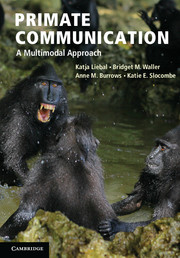Book contents
- Frontmatter
- Contents
- Preface
- Acknowledgements
- Part I Introduction to primate communication
- Part II Approaches to primate communication
- Part III Cognitive characteristics of primate communication
- 6 Acquisition
- 7 Flexibility
- 8 Intentionality
- 9 Referentiality
- Part IV Approaches to the evolution of primate communication
- Glossary
- References
- Species index
- Subject index
6 - Acquisition
Published online by Cambridge University Press: 05 December 2013
- Frontmatter
- Contents
- Preface
- Acknowledgements
- Part I Introduction to primate communication
- Part II Approaches to primate communication
- Part III Cognitive characteristics of primate communication
- 6 Acquisition
- 7 Flexibility
- 8 Intentionality
- 9 Referentiality
- Part IV Approaches to the evolution of primate communication
- Glossary
- References
- Species index
- Subject index
Summary
An understanding of how and when animals acquire communication can be useful to expose the cognition underlying the production and perception processes of communication. As a great many changes occur in early life, of particular interest is acquisition of communication from birth to reaching adulthood (during ontogeny or development). Acquisition and modification of communicative processes could still occur during adulthood, however, which may be similarly (or even more) indicative of interesting underlying processes. The extent to which communication is flexible in the adult, therefore, is also an important consideration. Chapter 7 focuses on flexibility in more detail, but the two topics are necessarily intertwined.
Scientists are interested in how and when communicative processes develop during an animal’s lifetime for two main reasons. First, by studying the sequence in which early communication emerges, the extent to which communicative skills are reliant or connected to the emergence of other skills and cognitive processes can be determined. For example, if a communicative skill manifests in humans before Theory of Mind has been acquired, this demonstrates that Theory of Mind is not necessary for that specific communicative skill to be used. In this way, the components of complex communicative abilities can be disentangled (which may be difficult to do in the adult) and the manner in which they interact can be better understood.
- Type
- Chapter
- Information
- Primate CommunicationA Multimodal Approach, pp. 131 - 153Publisher: Cambridge University PressPrint publication year: 2013



